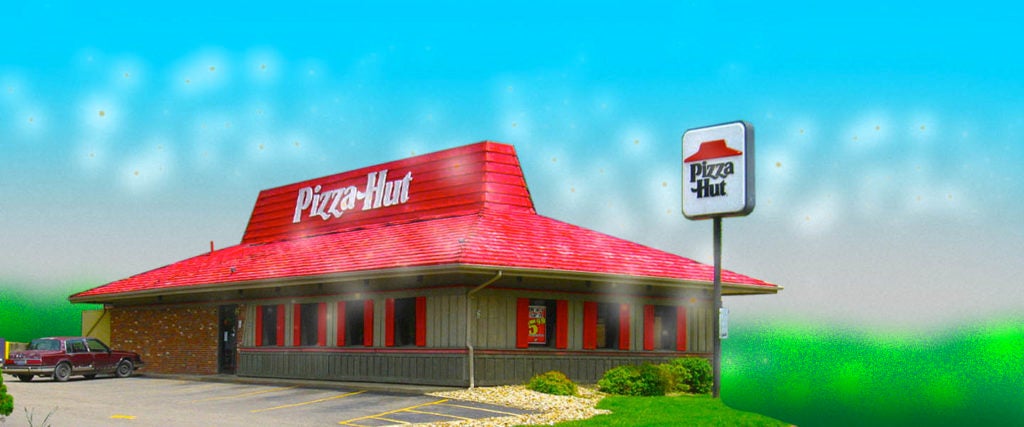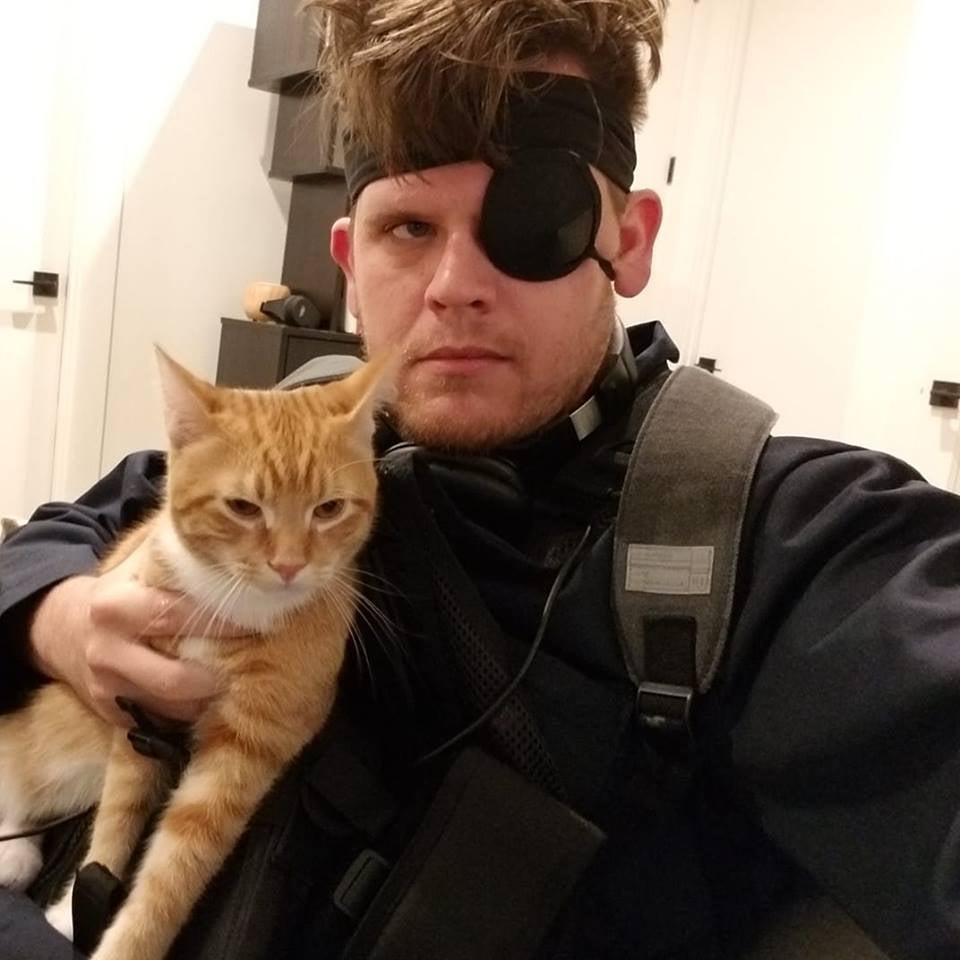There was a time, long ago, when ordering at Pizza Hut wasn’t a dehumanizing experience. The restaurant wasn’t bereft of all tables and chairs; you didn’t stand under the atonal clatter of dehumidifiers as a disaffected high school junior pounded in your order; and management hadn’t yet pared back all of the doodads, decorations and accessories in order to create the leanest, most ruthlessly efficient pizza-producing enterprise possible.
Yes, we speak of that moment in the 1980s and 1990s when the Hut worshipped at the altar of casual dining. When waiters would escort giddy family units to plush maroon booths, as the kitchen steadily pumped out pepperoni pies baked to perfection in scalding-hot metal pans. When flocks of Little Leaguers ping-ponged around the foyer, plunking quarters into jukeboxes or Coca-Cola-stained arcade cabinets, each buzzing with euphoric anxiety for the sleepovers and mischief in the hours ahead. Sometimes, if you arrived in the early afternoon, Pizza Hut offered its customers an overflowing, never-ending lunch buffet. It was there, munching on crunchy breadsticks, briny Caesar salad and a sausage-and-mushroom slice, that you’d remember how much quiet dignity there is to be found in suburban living.
All of those satisfactions have been sanded away over the years. Pizza Hut was established in 1958 as a humble, neighborhood pizzeria in Wichita, Kansas, and slowly metastasized into the rest of the country — and then the world. In 1986, Pizza Hut opened its 5,000th location in Dallas, firmly establishing it as a haven for strip-mall luxury for suburbanites all across the atlas. In fact, if you were born anywhere between the late 1970s and early 1990s, it’s likely that you’ve celebrated numerous classmate birthdays, varsity football victories and straight-A report cards within the lush grasp of the Hut’s red-roofed interior.
Unfortunately, that tradition is rapidly dying out from American life. The sit-down Pizza Hut, already endangered, is threatening to disappear completely. In 2019, the franchise’s corporate ownership — Yum! Brands — announced that they were purging more than 500 of the restaurant’s remaining dining rooms, bringing the total number of those old-school establishments to 7,000. (The company has nearly 20,000 locations total.) It makes business sense, said Yum! Brands COO David Gibbs, to focus on Pizza Hut’s delivery-only options — those postage stamp-sized hovels, awash in harsh fluorescent light, that purge any of the downhome comfort longtime fans associated with the kitchen. To be fair, the praxis is sound; even before the pandemic, Americans were going out to dinner at a declining rate, which experts claim is a symptom of Netflix libraries and online grocery orders.
But personally, there remains a deep, inarticulable melancholy in watching Pizza Hut warp into a glorified fast-food joint. Is nothing sacred?
Pizza Hut, of course, is far from the only restaurant to dramatically pivot its business model. McDonald’s divested away from its tried-and-true carbohydrate-heavy menu for apple slices, keto wraps and oatmeal; Bostonians sparked a brief revolt when Dunkin’ dropped the “Donuts” from its name. But for the most part, people accept the changes and move on. There are more important stresses in this world than the sanctity of our preferred chain eateries, right? So why then do so many people still mourn the Pizza Hut they remember? Why is the demise of the Classic Red Roof Experience such a sticking point for those of us who’ve already suffered the trauma of IHOB, and the death of the Seven Layer Burrito?
“[With a] fast-food experience, you get your order and you go eat in the car or whatever. When you went to Pizza Hut, it was typically a family thing,” says Rebecca Rose, from Santa Barbara, who is a staunch sit-down Pizza Hut revivalist. “You went with a big party or a group of friends after a game or recital. So there are a lot of memories of your childhood, your friends, your school crush or your family getting together for a fun night out without having to do the dishes.”
Rose speaks to a theme I hear echoed from everyone I speak to about their ancestral Hut allegiances. Growing up, they claim, there was a stark difference between going out for dinner, and going out to Pizza Hut. “Depending on the location we went to, there was either the X-Men and Simpsons arcade cabinets, or the Avengers and Superman ones,” says Andrew Millington, in Texas. “I remember very specifically asking to go to one or the other depending on which I hadn’t played in a while.”
“It was where my family went out to eat as a treat,” adds Liz Kelly, who grew up in Wisconsin. “It was so exciting to get to go there for dinner and make it a whole event. There were other places like Chuck E. Cheese but Pizza Hut was a place that was special in a smaller group, and somewhere you actually loved the food, too.”
These hardcore Hut lifers haven’t taken this assault lying down. In fact, customers are doing all they can to preserve their memories, even as Yum! Brands lays siege to the nation’s lingering orthodox Pizza Huts. There’s a burgeoning market for the restaurant’s artifacts on eBay. Log on, and you can bid on the steel pans that have fed countless families, or those gigantic red plastic cups that would be filled, and re-filled, and re-filled, with soda alongside a caravan of grade-school friends. On r/Nostalgia, an image of a vintage Pizza Hut table lamp earns over 32,000 upvotes; beleaguered millennials take one look and immediately enter a trans-fat heavy fugue state, as a million untapped memories come rushing back all at once. “I can smell this picture,” writes one commenter. “Saturday night, the mini arcade, your folks are still alive, not a care in the world,” adds another.
Maybe this is a matter of timing. Andrew Marino, someone who is so passionate about the Hut he recorded a podcast about why the restaurant’s stuffed crust pizza remains supreme, points out that if you belong to a certain age bracket, you likely watched the entire arc of Pizza Hut in real time. You entered its warm, enveloping bosom as a kid, and witnessed it being stripped for parts in the intervening years — running parallel to the many other disenfranchising traumas of harsh, cold adulthood. The other bastions of our sentimentality remain mostly intact; 31-year olds are welcome to visit the Denny’s of their childhoods, and hopefully the Dave & Buster’s of their college years are still standing. But a delivery-only Pizza Hut is a permanent reminder that you can never go home again. And more importantly, that you’re getting pretty old.
Pizza Hut clearly recognizes this market of crisis-laden, atemporal millennials who are quickly realizing that they’re burning off what’s left of what they can reasonably call their youth. The company brought back its classic logo last year, as well as a few old favorites from its bygone menu. In particular, Pizza Hut is running ads for its “original” pan pizza right now, with the hopes that distraught, past-prime burnouts will wander up to the skeletal outcropping of a takeout-only Pizza Hut, order a couple of pies and rush them back to their impoverished one-bedroom in hopes of tasting a fragment of that indelible existential security we abandoned back in 1998.
Of course, the greatest trick the devil ever pulled was convincing the world that it’s possible to serve nostalgia on a plate. “Maybe it’s my mind playing tricks on me, but [the new pan pizza] doesn’t have the same taste,” says Rose. If Pizza Hut was ever to go back to the well in good faith — if they want to earn the dollar of these despondent red-roof truthers — it would require a total reinvestment in the sit-down Pizza Huts they remember. After all, it was never about the pizza. “I’d want it to be dine-in, and capture the entire experience. Just bringing back the menu isn’t enough,” says Kelly. “It’s about eating under the lights, with the servers in their polos, in the sticky leather booths with a great group fighting over the last slice of pepperoni.”
Until then, the last surviving Pizza Hut nostalgists will wander the wasteland, watching the restaurant’s legacy take its place among the grand catalogue of 1990s relics that mature into greater tiers of gravitas the longer they’re left to memory (professional wrestling, Pavement, the surplus economy, etc.). That’s the most important element of being a Hut Head: You must understand the value of a brief, sweet trip — staring at an image of a plastic cup, and letting a tide of peculiar melancholia spirit you away.
“Ultimately we were just eating cheap pizza often left under a hot lamp at a buffet that was overpriced even for back then. But we don’t care about that in our memory,” Rose concludes. “We’re living in dreary times and the future doesn’t seem any brighter, so of course those silly things are going to feel more significant and meaningful. Because in a way, we kind of need them to.”

